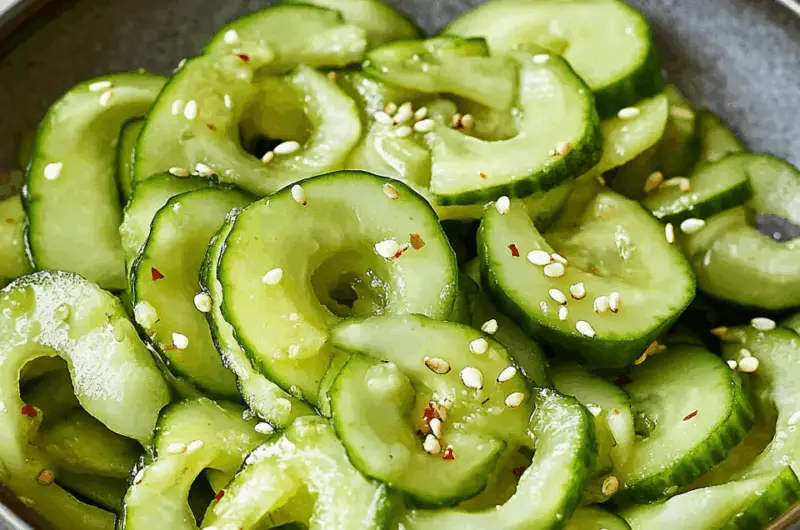The Japanese cucumber sunomono salad is a dish that embodies simplicity, balance, and elegance. With just a handful of ingredients—crisp cucumbers, tangy rice vinegar, a touch of sweetness, and savory soy sauce—this traditional side dish is a staple in Japanese cuisine. It’s refreshingly light yet full of flavor, making it a perfect complement to heartier main courses or a cooling palate cleanser on a warm day.
Whether you’re new to Japanese cooking or looking for a healthy dish that delivers flavor without fuss, Sunomono is a quick and easy choice. The delicate slicing, brief salting, and swift dressing come together effortlessly, offering a meditative experience in preparation and a burst of umami in each bite. This dish is ideal for meal prep, parties, or as an elegant starter that sets a serene tone for any meal.
Full Recipe:
-
2 cucumbers, thinly sliced
-
1 teaspoon salt
-
1/3 cup rice vinegar
-
2 tablespoons white sugar
-
1 teaspoon soy sauce
-
1 tablespoon toasted sesame seeds (optional)
Directions:
-
Place cucumber slices in a colander and sprinkle with salt. Let them sit for 5–10 minutes to draw out excess water.
-
Rinse the cucumbers with cold water and gently squeeze to remove remaining moisture.
-
In a bowl, whisk together rice vinegar, sugar, and soy sauce until sugar is dissolved.
-
Add cucumbers to the bowl and mix well to coat.
-
Chill in the refrigerator for 15–20 minutes before serving.
-
Optional: sprinkle toasted sesame seeds on top just before serving.
Prep Time: 10 minutes | Cooking Time: 0 minutes | Total Time: 20 minutes
Kcal: 27 kcal | Servings: 5 servings
Introduction to Cucumber Sunomono
Cucumber Sunomono, a quintessential Japanese side dish, represents everything that Japanese cuisine is celebrated for: simplicity, balance, and a deep appreciation of fresh ingredients. The term Sunomono refers to a category of vinegared dishes in Japan, and this cucumber-based version is by far one of the most popular. Traditionally served as an appetizer or a refreshing palate cleanser, cucumber sunomono is both delicious and healthy. Its crisp, light nature makes it a year-round favorite but especially cherished during the warm summer months.
The dish is a beautiful marriage of textures and flavors: thinly sliced cucumbers offer a satisfying crunch, while the tangy, sweet rice vinegar dressing brings depth and brightness. A hint of soy sauce adds umami, and the optional sesame seeds contribute a toasty nuttiness and a visual contrast. Often underestimated due to its simplicity, sunomono is a wonderful example of how a few well-chosen ingredients can come together to create something truly special.
Cultural Significance in Japanese Cuisine
In Japanese culinary tradition, balance and seasonality are paramount. Dishes are crafted not only to please the palate but also to harmonize with the season and other dishes being served. Sunomono plays a crucial role in this symphony, especially in kaiseki (a traditional multi-course meal) where it often appears as one of the side dishes.
The light acidity of sunomono helps cleanse the palate and prepare it for richer, more complex flavors. In a country where seafood features prominently, cucumber sunomono is sometimes enhanced with ingredients like wakame seaweed, octopus (tako), shrimp, or crab to add more dimension without overwhelming the dish. It’s also common in bento boxes and is often served in izakayas (Japanese pubs) as a small appetizer or bar snack.
Health Benefits of Cucumber Sunomono
From a nutritional standpoint, cucumber sunomono is an excellent choice for anyone seeking a low-calorie, hydrating, and nutrient-rich dish. Cucumbers are composed mostly of water, making them incredibly hydrating and refreshing. They are also a source of vitamin K, potassium, and small amounts of vitamin C and fiber.
The rice vinegar used in the dressing is known for its digestive properties and can help balance blood sugar levels. When used in moderation, soy sauce adds depth of flavor without contributing excessive calories. Adding toasted sesame seeds or a sprinkle of seaweed can elevate the dish nutritionally by introducing healthy fats and essential minerals.
For those on a plant-based diet or gluten-free regimen, sunomono is naturally vegan and easily made gluten-free by using tamari or gluten-free soy sauce. It’s a dish that caters to a wide variety of dietary preferences without sacrificing flavor or authenticity.
Texture and Flavor Profile
The charm of cucumber sunomono lies in its texture and taste. The thinly sliced cucumbers, typically prepared using a mandoline for uniformity, maintain a pleasant crunch even after marinating in the vinegar mixture. Salting the cucumbers beforehand is a crucial step—it draws out excess moisture and ensures the final dish is not watery but crisp and vibrant.
The dressing combines rice vinegar with sugar and soy sauce to achieve the characteristic flavor of sunomono: mildly sweet, slightly tangy, and umami-rich. It is subtle but distinct, complementing the cucumber’s freshness rather than overpowering it. When garnished with toasted sesame seeds or a small amount of finely shredded seaweed, the flavor becomes even more layered, offering a mix of nutty, briny, and bright notes.
Ideal Pairings and Occasions
Cucumber sunomono is incredibly versatile and can be paired with a wide range of dishes. It goes particularly well with sushi, grilled meats, teriyaki chicken, or tempura. Its crisp and acidic nature cuts through the richness of fried foods, offering balance and refreshment between bites.
It’s also a smart addition to meal prep or packed lunches. Because the cucumbers are marinated, the dish can be made ahead of time and stored in the refrigerator for up to two days without losing its crunch or appeal. Served cold, it’s a cooling companion to any spicy or hearty main dish.
For a more elaborate version suitable for special dinners, adding seafood such as shrimp or octopus transforms it from a humble side into a star appetizer. Meanwhile, minimalist versions are perfect for casual lunches, summer picnics, or light meals on hot days.
Tips for Perfect Sunomono Every Time
Achieving the perfect cucumber sunomono involves attention to a few key details. First, slicing the cucumbers thinly and uniformly ensures they absorb the dressing evenly. Japanese cucumbers or English cucumbers are preferred due to their thinner skins and fewer seeds. If using regular cucumbers, peeling and deseeding them is recommended to avoid bitterness and excess water.
Second, salting the cucumbers briefly is not optional. This step is vital for removing moisture and ensuring a crunchy texture. Be careful not to over-salt or over-marinate, as the cucumbers can become limp or too salty.
Third, taste and adjust the dressing to your preference. Some may enjoy a slightly sweeter profile, while others prefer a sharper tang. The proportions of rice vinegar, sugar, and soy sauce can be tweaked to match your palate or to complement other dishes in your meal.
Lastly, presentation matters. Sunomono is often served in small, shallow dishes or bowls, garnished with a pinch of sesame seeds or julienned seaweed. This not only enhances visual appeal but also stays true to Japanese aesthetic values of simplicity and elegance.
Variations and Creative Twists
Though the traditional cucumber sunomono is a minimalist dish, it welcomes creativity. One of the most popular additions is wakame seaweed, which brings a contrasting softness and oceanic flavor. Other common variations include:
-
Seafood Sunomono: Add blanched shrimp, cooked octopus, or imitation crab for protein and extra flavor.
-
Mixed Vegetable Sunomono: Include thinly sliced carrots, daikon radish, or even slivers of bell pepper for color and crunch.
-
Spicy Sunomono: A touch of chili oil or thinly sliced red chili can introduce a pleasant heat, perfect for those who like a spicy kick.
-
Fruit-Infused: Thin slices of Asian pear or green apple can add a delicate sweetness and an unexpected twist.
These adaptations allow sunomono to shine in both traditional Japanese settings and fusion-style meals, expanding its role from a simple side dish to a customizable culinary canvas.
Conclusion
Cucumber sunomono is far more than just a salad—it’s a celebration of Japanese culinary philosophy. Its clean flavors, minimal ingredients, and satisfying crunch make it a timeless side dish suitable for nearly any occasion. Whether you’re exploring Japanese cuisine for the first time or looking to diversify your healthy meal options, sunomono offers an elegant solution that is quick, affordable, and endlessly adaptable.
Its beauty lies not only in its simplicity but in how well it plays its role on the dining table: it refreshes the palate, complements stronger flavors, and delights the senses with every crisp, vinegary bite. As more home cooks around the world embrace global flavors, cucumber sunomono serves as a perfect entry point into the refined, refreshing world of Japanese side dishes.








